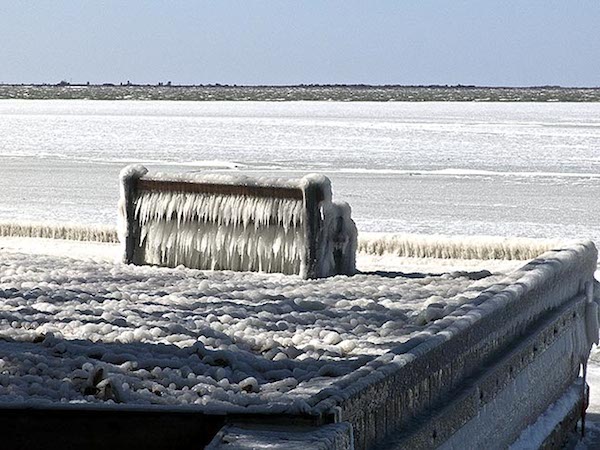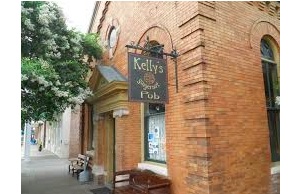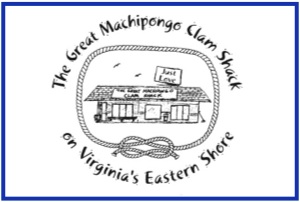PHOTO: (Not) Sittin’ on the Dock of the Bay

Intrepid photographer Gertraud Fendler documents how the Bay looked yesterday (Sunday, February 15) at 15 degrees in the morning with wind gusts up to 50 mph. An icicle-covered bench will have to wait a long time for a customer.
BOARD OF SUPERVISORS MEETING
Teachers Moonlight to Feed Families
By WAYNE CREED
Cape Charles Wave
February 16, 2015
With temperatures dipping into the low 30s, and with whipping winds over 40 knots, many folks still braved the harsh elements to attend the February 10 Regular Meeting of the Northampton Board of Supervisors. The room was close to capacity, with the entire back section filled with educators and others that support the mission of our county schools. This evening would introduce the year’s budget request from all aspects of county government; those who came to support schools were there to send a message to the Board. Most were wearing translucent blue ribbons, meant to symbolize unity and support for our teachers, as well as invoking a message of transparency in the coming budget process.
During the citizen information period, Occohonack math teacher Justin Wheeler (also Northampton president of local NEA), passionately addressed the BOS, saying that even as teachers work in a field that will have the most impact socially and fiscally (work that many consider the most vital to the County’s future), they are hardly compensated in a way that matches their contributions.
Wheeler freely offered his own pay stub, and ran down his monthly expenses. After tallying them up, his budget was not balanced. In order to make ends meet, he has to work a second job (most teachers find themselves in the same position).
Wheeler went on to say, “Even as our workload is up, a testament to our dedication is that our schools in Northampton are now accredited.”
Leslie James, 4th and 5th grade science teacher at Occohonack, pleaded with the Board to hire another science teacher, which would relieve some of the pressure caused by teaching to the SOLs, and would allow them to truly focus on the subject matter.
Etta Robbins, a 40 year veteran of our schools, requested that the BOS do what they can to replace the high school and the middle school. “We can’t compete with other areas like Northern Virginia and Virginia Beach” until we upgrade our facilities. She, like most educators in the room, also urged the board to raise teacher salaries: “We need to find a way to keep our teachers here. Just last year, we lost four of our best teachers.”
Discussion then turned to the proposed county zoning, and a critique of the county’s “Citizen Information Paper.” Ken Dufty of Exmore attacked the paper, saying, “It fails miserably” in helping citizens really understand what the intentions of the new zoning really are, and in fact, “misleads and misinforms.” Dufty took issue with the proposed uses and the way they were portrayed in the paper. Even as the paper listed more innocuous uses, such as “art studios, kennels, schools,” a closer look at the actual “Draft Proposal” document revealed things such as “prisons, dredge spoil sites, mining excavation sources,” which Dufty called “a blatant attempt to mislead.” Dufty also criticized the removal of the Town Edge District, stating that once most of the Town Edge went back to agriculture, it would open the county up to a number of invasive uses (that he mentioned above). [Read more…]
LETTER: Animal Compassion Is More than Just Pets
February 16, 2015
DEAR EDITOR,
I read Wayne Creed’s article (“Animal Abuse, Theft Highlight Longtime Problems”) with great interest, being aware of the minimal care frequently afforded companion animals by their owners on the Eastern Shore. Friends who moved to Accomack three years ago were so distressed by the harsh treatment of dogs and other animals they observed in many yards that they started providing straw bedding, food and education, even doing repairs in some instances.
Their experience was that while some of the pet owners they helped were happy to receive the purchases and labor, it did not appear they would follow up on their own. Last time we talked, my friends said they had to step back from the toll the situation was taking on their own mental health and resources.
But it isn’t only dogs and cats who suffer from abuse and neglect on the Eastern Shore (and in other parts of Virginia). Chickens and many other animals suffer through every phase of their existence as a result of their status as agricultural animals.
Many of those who abuse and neglect their companion animals work in animal agribusiness where a total lack of compassion for animals, even pleasure in watching them suffer, prevails. People who spend their days being violent toward chickens and other farmed animals as part of their job often bring the violent culture of their employment home with them.
How many residents know that a Virginia statute titled “Care of Agricultural Animals by Owner” (Section 3.2-6503.1) allows the owners of agricultural animals to deprive their animals of food and water up to the point of starvation and dehydration and exempts the owners from providing bedding or shelter, regardless of the weather, for their animals? [Read more…]
Flood Insurance Going Down — But for How Long?
By WAYNE CREED
Cape Charles Wave
February 16, 2015
Historically, the towns of the Eastern Shore have been thought to be at risk from flooding. Flood insurance has always been scarce, and in the 1920s, since it was deemed unprofitable, the insurance industry basically dropped flood insurance (even when it was available, it was too high to attract customers that lived in flood plains).
In the 1960s, Congress began to feel that the way the country was dealing with natural disasters such as floods was expensive and inefficient. They felt that Federal flood programs were funded by all taxpayers, but only benefitted those that lived in flood plains, and who, even after experiencing disaster, would continue to live and build there. In 1968, Congress passed the National Flood Insurance Act which sought to move the costs of flood losses from taxpayers to the actual property owners that lived in flood plains.
The method chosen was to provide flood insurance premiums to flood plain residents. Congress attempted to try and influence development away from risky flood hazard areas, and required that new buildings be built to minimize flood damage.The Federal Insurance Administration (which at that time was in the Department of Housing and Urban Development) was in charge of the program.
Still, participation was weak, and few communities joined the program. In 1972, when hurricane Agnes ravaged the east coast, it was discovered that only 100,000 homes had the insurance. This led to the Flood Disaster Protection Act of 1973, which required that buildings located in identified flood hazard areas must have “flood insurance coverage as a condition of federal aid or loans from federally insured banks and savings and loans and as a condition for receiving federal disaster.” This worked, as more than 2 million polices soon went into effect.
In 1979, the Federal Emergency Management Agency took over the program. FEMA created a floodplain map and developed flood hazard data allowing areas to use them as a structural basis for regulating construction in areas that are prone to flooding. The first version was called the Flood Hazard Boundary Map. However, most places had their FHBM replaced by a Flood Insurance Rate Map, which usually has flood elevations and other flood hazard data.
Effective May 18, 2015, the updated version of the FEMA Flood Insurance Rate Maps will be in place. Due to the updated maps, Cape Charles must adopt an updated Flood Plain Ordinance by March 2, 2015, and submit it to the FEMA Regional Office. For most of us living in Cape Charles, we have become very familiar FEMA flood insurance, and our own Flood Insurance Rate Map. [Read more…]
COMMENTARY
Eastern Shore ‘Too Special to Drill’? –Nope

EXHIBIT A: The Chesapeake Bay at Cape Charles.
By JAY FORD
Virginia Eastern Shorekeeper
February 16, 2015
As part of the Administration’s announcement of new leases for offshore drilling, Secretary of the Interior Sally Jewell continually stated, “Some places are too special to drill.” Apparently, Virginia and the Eastern Shore didn’t make the cut.
Virginia’s Eastern Shore is the largest remaining stretch of coastal wilderness on the entire eastern seaboard of the United States. Additionally, the Eastern Shore has been recognized by the United Nations as an International Biosphere Reserve, and as a Western Hemisphere Shorebird Network Site. There is no place on earth like Virginia’s Eastern Shore; the very definition of special.
Less than five years since the BP disaster overwhelmed the Gulf Coast, our leaders are ready to open our region to the same risks. Our culture, our economy, and our quality of life are inextricably linked to the waters of the Atlantic and the Chesapeake Bay. Our booming aquaculture industry, fisheries, and tourism all depend on clean waters and are susceptible to the slightest changes. Even if we never had a major spill we would have tarballs on our beaches, and drilling fluid, toxic metals, and metal shavings in our ocean as part of the standard operating practice for an offshore rig.
If a spill were to occur, our very way of life on Virginia’s Eastern Shore would be forever altered. Researchers on the Gulf Coast are still trying to quantify the long term damage done to that region’s ecology as a result of oil and the subsequent dispersants. Mutations, deformed hearts, lesions, and sterility have been documented in staggering numbers throughout the fish population. Corals were wiped out, taking with them millenniums old ecosystems. Shrimp with no eyes and/or eye sockets were reported. Petroleum products and oil dispersant has been found in the shells of blue crab larvae and pelican eggs. When asked to put a dollar figure on the ecological damage many researchers had but one answer: “Priceless.” [Read more…]
Local SPCA Needs Community Support

A Cape Charles family poses with their SPCA bundle of Joy: Brendan, Reegan, Penny the beagle, Erilyn, and mom Kathryn.
By WAYNE CREED
Cape Charles Wave
February 16, 2015
The Shore SPCA was founded in 1970, and began its mission here by providing the shelter used for Animal Control Operations. During the past decade, SPCAs around the state were re-evaluating their operations and returning to their roots by providing food, shelter, and medical care to homeless pets and attempting to find them homes. In 2005, the Shore SPCA Board decided to take on that mission and became a no-kill limited intake shelter. Currently, Shore SPCA shelters, treats, rehabilitates, and finds homes for household companion animals in hopes of reducing some of the burden on the Regional Animal Shelter in Accomack.
Although sheltering and adoption are a key function, the need for affordable spay/neuter services as a humane way to manage the overall population is also a big concern. According to Maureen Lawrence, president of the Shore SPCA, since 2008, “we have raised close to $95,000” which went toward a low cost spay/neuter program aimed at lower-income residents. Much of this came in the form of grants ($2,500) from Accomack and Northampton counties. These funds allowed them to qualify for a matching grant. Since then, they have been able to spay or neuter 375 dogs, 990 cats, as well as 502 feral cats. The cost for the surgeries was a low $25 for dogs, and $15 for cats.
As successful as this may sound, as many non-profit organizations will testify, funds from government and foundations have become very hard to come by. Things are beginning to look up, but due to the downturn of the last few years, funds for the spay/neuter program have become so low that the program has had to be temporarily suspended. Ms. Lawrence asserts, “Foundations are increasingly reluctant” to fund spay/neuter programs “without buy-in from the community” and unless they can show a means to sustain the program.
Ms. Lawrence remains optimistic, “We’ve asked Northampton for $3,500, and Accomack for $9,000.” The hope is to amass $12,500, hoping to get a matching grant.
It takes close to $25,000 per year to operate a program that services 500 animals. There has been some criticism that the SPCA has not been doing enough relative to gathering funds, as well as leveraging more from the volunteer community. Ms. Lawrence understands the criticism, and admits the last few years have been tough (not just for the SPCA), but adds that they are constantly re-evaluating the process. “The good news is we have a wonderful grant writer” that will be working hard to get the program back to where it was. [Read more…]
FRIDAY 2/20: Peace Corps Volunteer Remembers Kazakhstan
“At Home on the Kazakh Steppe: a Peace Corps Memoir,” Science and Philosophy Seminar of the Eastern Shore of Virginia’s next free 90-minute seminar, will be held at 12:30 p.m. on Friday, February 20, in the Lecture Hall of the Eastern Shore Community College, 29300 Lankford Hwy., Melfa. Janet Givens will relate how as a Peace Corps volunteer she spent part of the 2000s teaching English in Kazakhstan. Givens is a psychotherapist living in the Green Mountains of Vermont.
SATURDAY 2/21: Chalk Painting Furniture Class
Chalk Painting with Heather Apgar: Saturday, February 21, from 3-5 p.m. in the Arts Enter Art Room at 10 Strawberry Street. [Read more…]



















